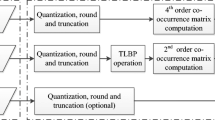Abstract
Recently, deep learning has been used in steganalysis based on convolutional neural networks (CNN). In this work, we propose a CNN architecture (the so-called maxCNN) to use the selection channel. It is the first time that the knowledge of the selection channel has been incorporated into CNN for steganalysis. The proposed method assigns large weights to features learned from complex texture regions while assigns small weights to features learned from smooth regions. Experimental results on the well-known dataset BOSSbase have demonstrated that the proposed scheme is able to improve detection performance, especially for low embedding payloads. The results have shown that with the ensemble of maxCNN and maxSRMd2+EC, the proposed method can obtain better performance compared with the reported state-of-the-art on detecting WOW embedding algorithm.
Access this chapter
Tax calculation will be finalised at checkout
Purchases are for personal use only
Similar content being viewed by others
References
Filler, T., Judas, J., Fridrich, J.: Minimizing additive distortion in steganography using syndrome-trellis codes. IEEE Trans. Inf. Forensics Secur. 6(3), 920–935 (2011)
Pevný, T., Filler, T., Bas, P.: Using high-dimensional image models to perform highly undetectable steganography. In: Böhme, R., Fong, P.W.L., Safavi-Naini, R. (eds.) IH 2010. LNCS, vol. 6387, pp. 161–177. Springer, Heidelberg (2010). doi:10.1007/978-3-642-16435-4_13
Holub, V., Fridrich, J.: Designing steganographic distortion using directional filters. In: 2012 IEEE International Workshop on Information Forensics and Security (WIFS), pp. 234–239 (2012)
Holub, V., Fridrich, J., Denemark, T.: Universal distortion function for steganography in an arbitrary domain. EURASIP J. Inf. Secur. 2014(1), 1 (2014)
Li, B., Wang, M., Huang, J., Li, X.: A new cost function for spatial image steganography. In: Proceedings of IEEE ICIP, Paris, France, pp. 4206–4210, October 2014
Sedighi, V., Cogranne, R., Fridrich, J.: Content-adaptive steganography by minimizing statistical detectability. IEEE Trans. Inf. Forensics Secur. 11(2), 221–234 (2016)
Fridrich, J., Kodovsky, J.: Rich models for steganalysis of digital images. IEEE Trans. Inf. Forensics Secur. 7(3), 868–882 (2012)
Tang, W., Li, H., Luo, W., Huang, J.: Adaptive steganalysis against WOW embedding algorithm. In: Proceedings of ACM IH&MMSec, pp. 91–96 (2014)
Tang, W., Li, H., Luo, W., Huang, J.: Adaptive steganalysis based on embedding probabilities of pixels. IEEE Trans. Inf. Forensics Secur. 11(4), 734–745 (2016)
Denemark, T., Sedighi, V., Holub, V., Cogranne, R., Fridrich, J.: Selection-channel-aware rich model for steganalysis of digital images. In: Proceedings of Information Forensics Security (WIFS), pp. 48–53, December 2014
Denemark, T., Boroumand, M., Fridrich, J.: Steganalysis features for content-adaptive JPEG steganography. IEEE Trans. Inf. Forensics Secur. 11(8), 1736–1746 (2016)
Holub, V., Fridrich, J.: Low-complexity features for JPEG steganalysis using undecimated DCT. IEEE Trans. Inf. Forensics Secur. 10(2), 219–228 (2015)
Holub, V., Fridrich, J.: Phase-aware projection model for steganalysis of JPEG images. In: Proceedings of SPIE, vol. 9409, p. 94090T, February 2015
Song, X., Liu, F., Yang, C., Luo, X., Zhang, Y.: Steganalysis of adaptive JPEG steganography using 2D Gabor filters. In: Proceedings of the 3rd ACM IH&MMSec. Workshop, pp. 15–23, June 2015
Tan, S., Li, B.: Stacked convolutional auto-encoders for steganalysis of digital images. In: Proceedings of APSIPA, pp. 1–4, December 2014
Qian, Y., Dong, J., Wang, W., Tan, T.: Deep learning for steganalysis via convolutional neural networks. In: Proceedings of SPIE Electronic Imaging, p. 94090J, March 2015
Qian, Y., Dong, J., Wang, W., Tan, T.: Learning and transferring representations for image steganalysis using convolutional neural network. In: 2016 IEEE International Conference on Image Processing (ICIP), Phoenix, AZ, pp. 2752–2756, September 2016
Xu, G., Wu, H., Shi, Y.: Structural design of convolutional neural networks for steganalysis. IEEE Signal Process. Lett. 23(5), 708–712 (2016)
Xu, G., Wu, H.-Z., Shi, Y.Q.: Ensemble of CNNs for Steganalysis: an empirical study. In: Proceedings of the 4th ACM Workshop on Information Hiding and Multimedia Security. ACM (2016)
Kodovsky, J., Fridrich, J., Holub, V.: Ensemble classifiers for steganalysis of digital media. IEEE Trans. Inf. Forensics Secur. 7(2), 432–444 (2012)
Sedighi, V., Fridrich, J.: Histogram layer, moving convolutional neural networks towards feature-based steganalysis. In: IS&T/SPIE Electronic Imaging, Burlingame, California, 29 January - 2 February 2017
Holub, V., Fridrich, J.: Random projections of residuals for digital image steganalysis. IEEE Trans. Inf. Forensics Secur. 8(12), 1996–2006 (2013)
Ioffe, S., Szegedy, C.: Batch normalization: accelerating deep network training by reducing internal covariate shift, February 2015. arXiv:1502.03167
Bas, P., Filler, T., Pevný, T.: “Break our steganographic system”: the ins and outs of organizing BOSS. In: Filler, T., Pevný, T., Craver, S., Ker, A. (eds.) IH 2011. LNCS, vol. 6958, pp. 59–70. Springer, Heidelberg (2011). doi:10.1007/978-3-642-24178-9_5
Jia, Y., Shelhamer, E., Donahue, J., Karayev, S., Long, J., Girshick, R., Guadarrama, S., Darrell, T.: Caffe: convolutional architecture for fast feature embedding. In: Proceedings of ACM International Conference Multimedia, pp. 675–678 (2014)
Liu, K., Yang, J., Kang, X.: Ensemble of CNN and rich model for steganalysis. In: 2017 IEEE International Conference on Systems, Signals and Image Processing (IWSSIP), pp. 1–5 (2017)
Acknowledgements
This work was supported by NSFC (Grant nos. U1536204, 61379155), Special funding for basic scientific research of Sun Yat-sen University (6177060230).
Author information
Authors and Affiliations
Corresponding author
Editor information
Editors and Affiliations
Rights and permissions
Copyright information
© 2017 Springer International Publishing AG
About this paper
Cite this paper
Yang, J., Liu, K., Kang, X., Wong, E., Shi, Y. (2017). Steganalysis Based on Awareness of Selection-Channel and Deep Learning. In: Kraetzer, C., Shi, YQ., Dittmann, J., Kim, H. (eds) Digital Forensics and Watermarking. IWDW 2017. Lecture Notes in Computer Science(), vol 10431. Springer, Cham. https://doi.org/10.1007/978-3-319-64185-0_20
Download citation
DOI: https://doi.org/10.1007/978-3-319-64185-0_20
Published:
Publisher Name: Springer, Cham
Print ISBN: 978-3-319-64184-3
Online ISBN: 978-3-319-64185-0
eBook Packages: Computer ScienceComputer Science (R0)




